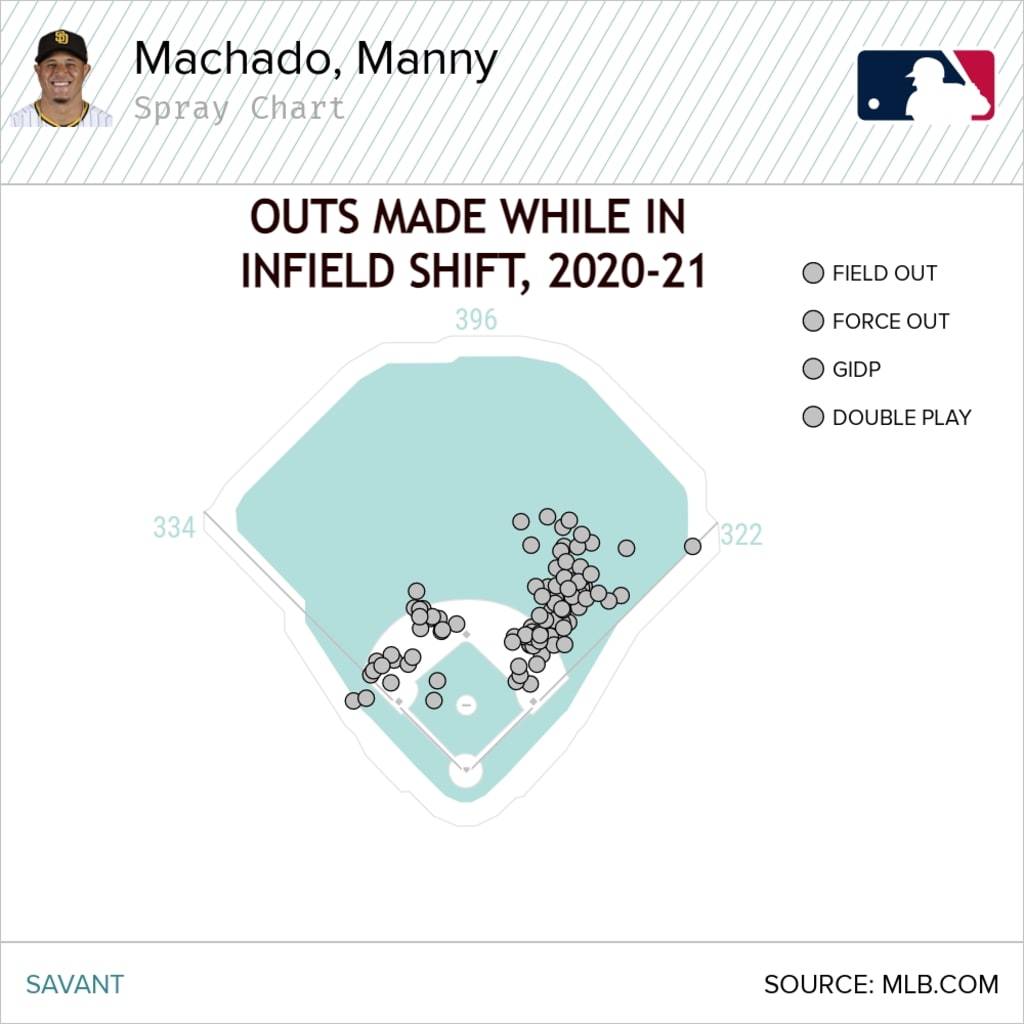When is a third baseman not a third baseman anymore? How far does he have to go to become something else?
Across the diamond? Into the outfield? What are you when you're fielding a ground ball on the left side of the infield one play and making a catch in the recesses of the right-field corner the next?
You're Manny Machado, MLB's unicorn infielder.
Over the last two seasons, as the Padres have become contenders in the National League West, they've also been redefining the boundaries of what it means to play the third base position with one of their superstar players. Machado in the field is a true rover. He doesn't just play a straight-up third base, or take over the left side of the infield in a shift, or bounce across the field to situationally play the second-base spot. He will, with frequency, play 200 feet deep in the outfield … and in right field, on the opposite side of the field from his natural position.
He's the only one who does it. Not just the only third baseman. The only infielder. Call it the Machado Shift.
Infielders with most plays starting 200+ feet deep since 2020
1) Manny Machado (SD): 811
2) Brandon Lowe (TB): 87
3) Yonny Hernández (TEX): 30
4) (tie) Cavan Biggio (TOR): 18
4) (tie) Rougned Odor (NYY): 18
Or, to summarize it another way …
Machado: 811 plays with starting depth of 200+ feet
All other MLB infielders: 335 plays with starting depth of 200+ feet
Machado has nearly 10 times more plate appearances spent in an "extreme rover" position as any other infielder. He plays that spot well more than twice as often as the rest of the league combined.
Even if you lower the starting depth threshold to 180 feet -- as in, twice as deep as the distance from home to first, and a range that some infielders and teams have started to explore in the modern game -- there's no comparison.
Infielders with most plays starting 180+ feet deep since 2020
1) Manny Machado (SD): 941
2) Jose Altuve (HOU): 558
3) David Fletcher (LAA): 477
4) Whit Merrifield (KC): 471
5) Rougned Odor (NYY): 438
And if you look closely at the two lists, you'll notice that the difference between Machado's number of plays at 180-plus feet and 200-plus feet is small. That is, when he plays the rover, he's almost always playing that super-deep rover.
The way the Padres have come to deploy Machado as a third baseman over the last two seasons is unique. Against many powerful left-handed hitters, his starting position will be so deeply shifted on the right side that he's almost a fourth outfielder. And that's made unique plays possible.
The Padres can use Machado like this because Machado is a special-case defender. They essentially created this deep rover position ad hoc, just for Machado, which creates an entirely new base set of defensive plays for the fielder to make. No fielding action is the same for a third baseman when he's doing that action from 200-plus feet out in right field.
But don't call it learning a new position. Machado doesn't see it that way.
"I mean, what is there to learn?" he told MLB.com's AJ Cassavell. "I don’t really know. There’s nothing to learn. Defense is defense. Catch the ball, make the out. There’s nothing more to it."
Really, though, there is a lot to that. To catch the ball, make the out from the Machado Shift, you have to be a fielder like Machado.
Machado has the range to make diving catches on hard line drives, to chase down ground balls toward center field or the right-field line, to track fly balls that normally only an outfielder would play. He has the arm strength to make the long throws to first from the middle of the outfield, even if he's on the run to his right or his left and throwing across his body.
Those aren't hypotheticals. Machado has a two-year rover highlight reel with multiple examples of him getting each of those types of outs from deep in the right-field grass.

? Here he is making an amazing diving catch on a line drive with only 2.1 seconds of hang time -- a ball that, per Statcast, is a hit nine out of 10 times. His starting depth was 218 feet.
? Here he is ranging 33 feet toward the line and making a 90 mph spin-o-rama throw to first from 124 feet away. Starting depth: 218 feet again.
? Here he is making a quick-release throw in just six-tenths of a second to get Cody Bellinger, whose sprint speed down the line was a near-elite 29.6 ft/sec. Machado started 207 feet deep and still got the out on a fast runner.
? Here he is leaping to snare a line drive that would have traveled 232 feet, possible only because his starting depth was 202 feet on the play.
? Here he is positioned in just the right spot -- 220 feet deep -- to easily take a hit away from Bryce Harper on a 113.6 mph line drive. It was Harper's third-hardest-hit ball of the year … and his hardest out.
This all started in Summer Camp 2020, when the Padres decided they had an innovative way to get even more out of their all-world third baseman. Machado always had rare tools at the hot corner, especially his arm. But why waste him in the corner of the diamond for batters who hit almost exclusively to the other half of the field? And once you transfer Machado to the left side, why not let him roam deep, where he can show the arm? Long throws across the diamond become long throws into the diamond. Hits for slugging lefties become outs.
"The design is to put guys that are really good with their ball security in hot lanes where, hopefully, the ball is going," Padres manager Jayce Tingler said at the time.
And Machado went out there, alone among MLB third basemen, and proved he can win the Padres extra outs. He's not worried about differentiating too much between them either, the hardest plays as the rover vs. the easiest.
"I don't know, man, that's a tough question," he said. "For me, it’s always just catch the ball, make the out. That’s just the nature of it. It's get to the ground ball and make the out. That’s just how I see it. Some might be harder [plays] than others. I'm blessed that I have an arm where I can make strong throw. But I'm just trying to make the play."
Still, because the Machado Shift is not replicated across baseball, he's the only player actually out there making those plays. There are certain hits that only he takes away. So maybe instead of an evolution of the infield shift, it's more of a mutation.
The average MLB third baseman, when he's playing in a shifted infield, starts 130 feet from home plate. When Manny Machado is the third baseman in a shifted infield, his average starting depth is 170 feet. That's 40 feet deeper than a typical shifted third baseman.
Of all the third basemen who have spent regular time in a shift this season, the one who plays the next-deepest in shifts is the Yankees' Rougned Odor … at 145 feet -- still 25 feet shallower than Machado. The gap between Machado and Odor, the deepest and second-deepest third basemen, is basically the same as the gap between Odor and the shallowest third baseman, the Rays' Yandy Díaz, at 118 feet.
Those numbers cover all shifts, including both right- and left-handed hitters. The gap between Machado and the rest of the league speaks both to how deep he plays in the rover position, and to how often the Padres use him in that particular kind of shift, which is the kind where the player will start the deepest.
But even looking at infield shifts against only left-handed hitters, where the third baseman is more likely to be playing deeper on the right side of the field, Machado still is in a territory to himself.
His average starting depth in a shift against a left-handed hitter is 173 feet. The typical MLB third baseman in that situation has an average starting depth of 135 feet. It's still a near-40-foot difference. The Braves' Austin Riley (160 feet) and the Brewers' Luis Urías (150 feet) are the only others who even approach Machado's zone of the field.
Deepest 3B in shifts against LHB, 2021
1) Manny Machado (SD): 173 feet
2) Austin Riley (ATL): 160 feet
3) Luis Urías (MIL): 150 feet
4) DJ LeMahieu (NYY): 144 feet
5) Cavan Biggio (TOR): 143 feet
The results of all this are what look like ordinary lines in a game log. "Joey Gallo pops out to third baseman Manny Machado." "Kyle Tucker flies out to third baseman Manny Machado." "Tucker Barnhart grounds out, third baseman Manny Machado to first baseman Eric Hosmer." But the plays, and the diversity of those plays, are anything but ordinary.
And the Machado Shift has worked. As FanGraphs noted earlier this season, the Padres have gone from one of the worst teams at suppressing left-handed hitter offense via the shift to one of the best -- and the turning point was between 2019 and 2020, when they first implemented the Machado Shift.
Lowest wOBA allowed when shifting against LHB since 2020
- Dodgers: .272
2) Padres: .276
3) Rays: .288
4) Yankees: .289
5) (tie) Brewers: .292
5) (tie) Giants: .292
League avg. wOBA allowed: .316
The Padres have been a top-five team in both seasons of the Machado Shift. Their experiment of letting Machado take over the shallow outfield is paying off in unique, highlight-reel outs, and outs, period.
